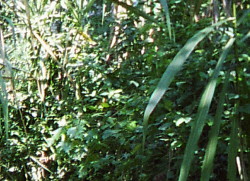 Photo.
Photo. Image of jungle for illustration.
© Travel Explorations.
The research group, with participants
from the US, Indonesia and Australia , trekked through an area in the
mist-shrouded Foja Mountains, located just north of the vast Mamberamo Basin of
north-western in New Guinea. Members from two local tribes joined the
research group. None of them had been there before. The area was described
as
"beautiful, untouched, unpopulated forest". There was
absolute no traces of human activity.
According to BBC`s website (www.BBC.com),
researchers have recorded butterflies, frogs, and a series of remarkable plants
that included five new palms and a giant rhododendron flower. The survey also
found a honeyeater bird that was previously unknown to science.
Click on the link for viewing photos of Papua`s lost world: Photos main
discoveries.
So far the survey has just been a "scratch of the
surface". The team will return later this year for exploring more of the
area.
Stein Morten Lund, 7 February 2006.
Additional information
West Papua is one of the world`s last frontiers. West
Papua covers the western half of the large island well known as New
Guinea. This part of the island belongs to Indonesia, and borders on
the Moluccas in the West, and Papua New Guinea in the East and Australia in the
South. West Papua is officially known as Irian Jaya. No less than 85% of the
island is covered by rainforest, much if it primary and untouched by
humans.
